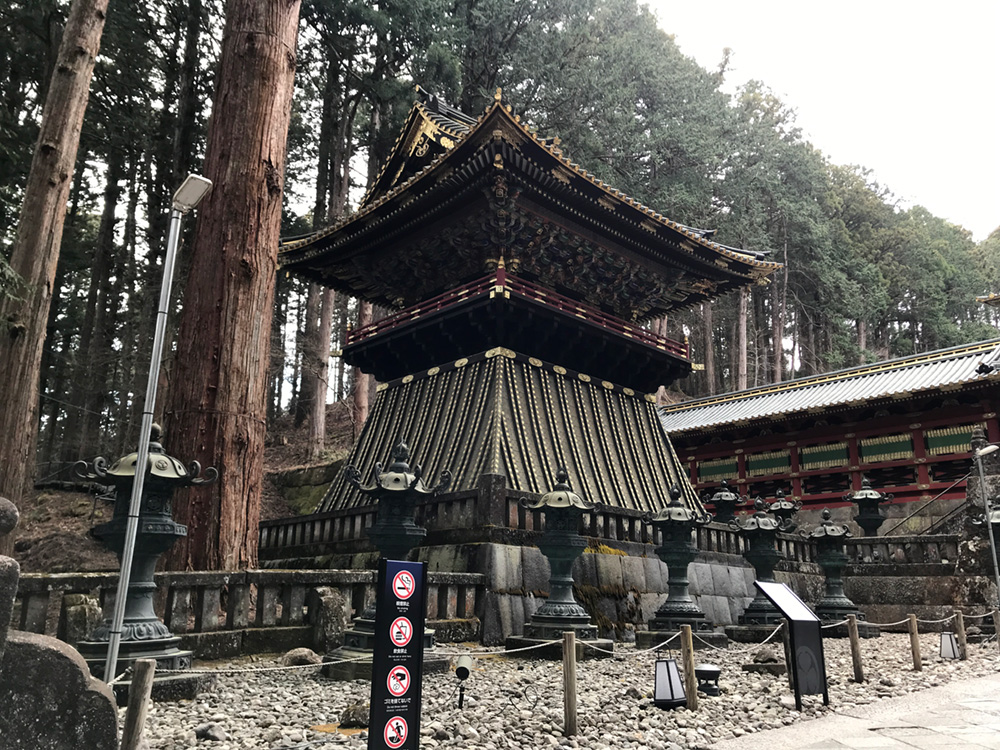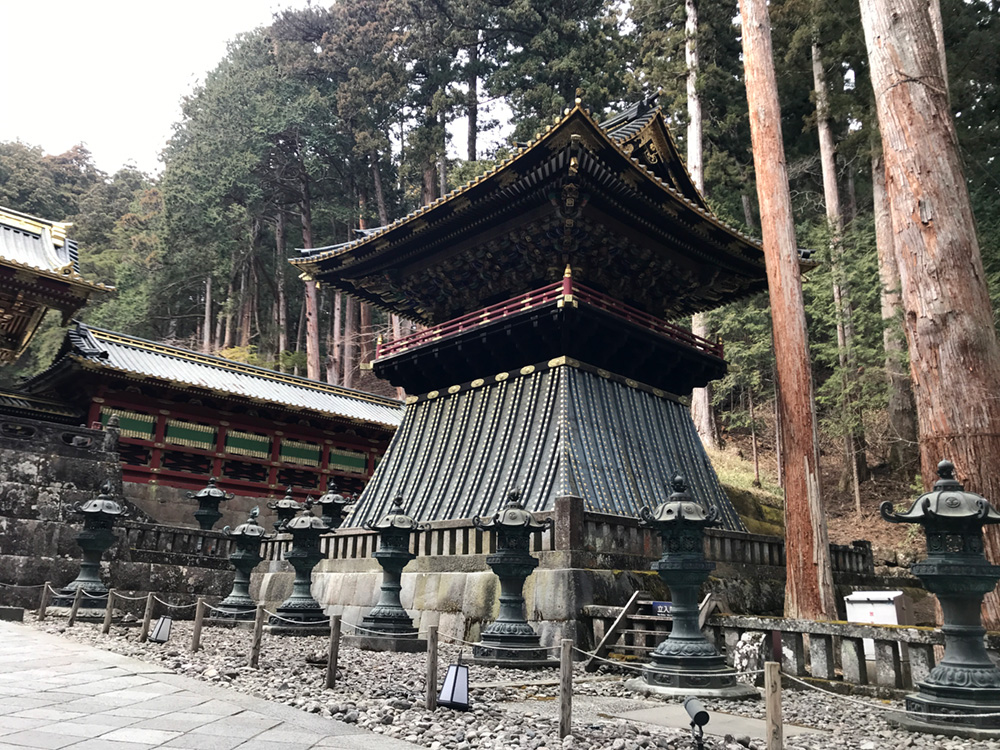鼓楼・鐘楼
Koro, Drum Tower, and Shoro, Bell Tower
鼓楼和钟楼
鼓樓和鐘樓
고로(고루), 쇼로(종루)
Korō, tour du tambour et Shōrō, le clocher
Koro, Trommelturm und Shoro, Glockenturm
Koro, la Torre del Tambor, y Shoro, el Campanario
หอกลองโคโร (Koro) และหอระฆังโชโร (Shoro)

鼓楼Koro, Drum Tower

鐘楼Shoro, Bell Tower
右側に鐘楼、左側に鼓楼がそびえます。鐘楼には釣鐘が、鼓楼には大きな太鼓がおさめられています。大きな法要の際には、この釣鐘と太鼓が打ち鳴らされました。
The two towers on either side of the path are the Drum Tower to the left and the Bell Tower to the right. Similar towers can be found outside temples all across Asia and were traditionally used to signal the time of day. At Taiyuin, the bell is rung for important memorial services. The large hanging bell and taiko drum in the towers were made in 1653. The two towers are beautifully decorated, but in a more reserved style than were the towers outside Ieyasu’s mausoleum at the Toshogu, to show Iemitsu's deference to his grandfather.
小路两侧的两座塔分别是左侧的鼓楼和右侧的钟楼。全亚洲的寺庙外都可以找到类似的宝塔,传统上用来指示一天中的时间。在大猷院,敲响钟声是为了重要的追悼仪式。宝塔的大吊钟和太鼓是1653年制成的。两座塔装饰精美,但风格上较德川家康的陵墓东照宫外的塔而言更加内敛,以示德川家光对祖父的尊重。
小路兩側的兩座塔分別是左側的鼓樓和右側的鐘樓。全亞洲的寺廟外都可以找到類似的寶塔,傳統上用來指示一天中的時間。在大猷院,敲響鐘聲是為了重要的追悼儀式。寶塔的大吊鐘和太鼓是1653年製成的。兩座塔裝飾精美,但風格上較德川家康的陵墓東照宮外的塔而言更加內斂,以示德川家光對祖父的尊重。
길의 양쪽에 있는데 왼쪽이 고루이고 오른쪽이 종루입니다. 아시아 전역의 사찰 밖에서 비슷한 것을 볼 수 있으며 전통적으로 시간을 알리는 데 사용되었습니다. 다인유인에서 종은 중요한 제사를 지낼 때 울립니다. 탑에 있는 커다란 종과 북은 1653년에 만들어졌습니다. 아름답게 장식되어 있지만, 할아버지에 대한 이에미츠의 경의를 담아 도쇼구의 이에야스 묘에 있는 것보다는 차분한 스타일입니다.
Les deux tours de chaque côté du chemin sont la tour du tambour à gauche et le clocher à droite. Des tours similaires se trouvent à l'extérieur de temples partout en Asie.Elles étaient traditionnellement utilisées pour indiquer l'heure de la journée. Au Taiyû-in, la cloche sonne pour les services commémoratifs importants. La grande cloche suspendue et le tambour taiko dans les tours furent fabriqués en 1653. Les deux tours sont joliment décorées, mais dans un style plus réservé que ne l'étaient les tours à l'extérieur du mausolée d'Ieyasu au Tōshō-gū, pour montrer la déférence d'Iemitsu envers son grand-père.
Die beiden Türme auf beiden Seiten des Pfades sind links der Trommelturm und rechts der Glockenturm. Ähnliche Türme findet man in den Außenbereichen der Tempel in ganz Asien. Sie wurden traditionell dafür eingesetzt, um die Tageszeit anzuzeigen. Im Taiyuin wird die Glocke für wichtige Gedenkfeiern geläutet. Die große hängende Glocke und die Taiko-Trommeln in den Türmen wurden 1653 angefertigt. Obwohl die beiden Türme sehr schön dekoriert sind, sind sie schlichter als die Türme, die außerhalb von Ieyasus Mausoleum am Toshogu stehen, da Iemitsu dem Großvater seine Ehrerbietung erweisen wollte.
Las dos torres erigidas a ambos lados del camino son la Torre del Tambor, a la izquierda, y el Campanario, a la derecha. En el exterior de los templos de toda Asia hay torres similares que se usaban tradicionalmente para señalar la hora del día. En el Taiyuin, la campana suena cuando se celebran ceremonias conmemorativas importantes. La gran campana colgante y el tambor taiko de las torres se elaboraron en 1653. Las dos torres están bellamente decoradas, pero en un estilo más reservado que el de las exteriores del mausoleo de Ieyasu en el Toshogu, para mostrar la deferencia de Iemitsu hacia su abuelo.
หอคอยทั้งสองข้างของทางเดิน คือ หอกลองที่อยู่ทางด้านซ้าย และหอระฆังที่อยู่ทางด้านขวา หอคอยที่มีลักษณะคล้ายกันนี้ สามารถพบได้ภายนอกวัดทั่วเอเชีย และมักใช้เป็นสัญญาณบอกเวลาของวัน ที่ไทยูอิน (Taiyuin) เสียงระฆังจะดังขึ้น ในพิธีรำลึกที่สำคัญ ระฆังและกลองไทโกะขนาดใหญ่ที่แขวนไว้ในหอคอยสร้างขึ้นในปี ค.ศ. 1653 หอคอยทั้งสองได้รับการตกแต่งอย่างงดงาม แต่ยังรักษารูปแบบไม่ให้เกินหน้าหอคอยที่อยู่ด้านนอกสุสานอิเอยาสุ ที่โทโชกุ (Toshogu) เพื่อแสดงความเคารพของอิเอมิตสึ (Iemitsu) ที่มีต่อปู่ของท่าน
